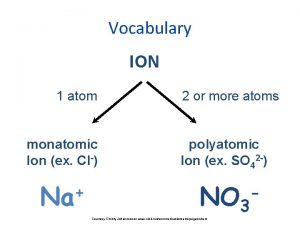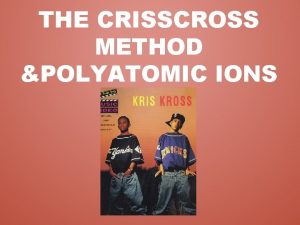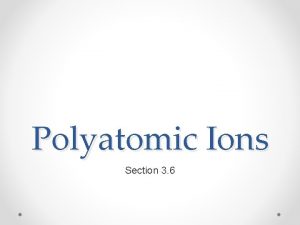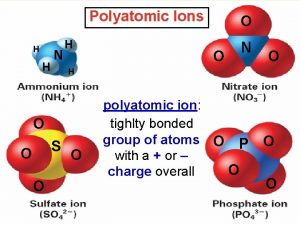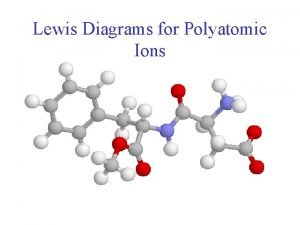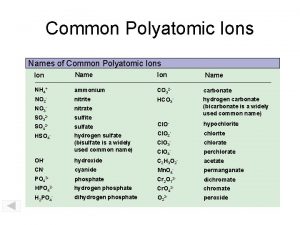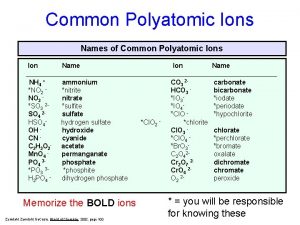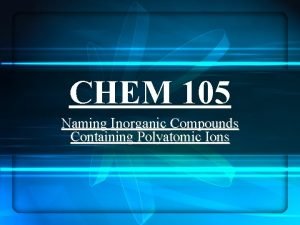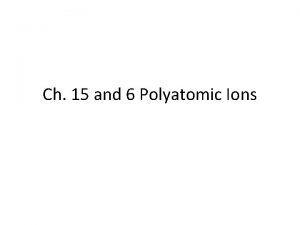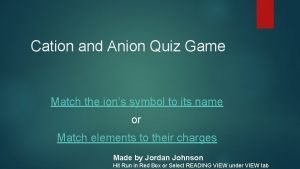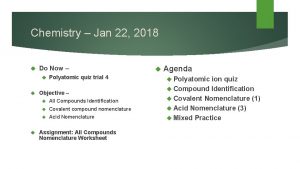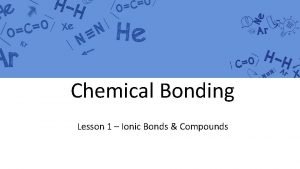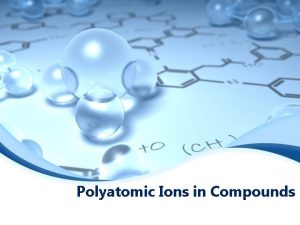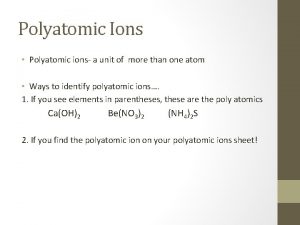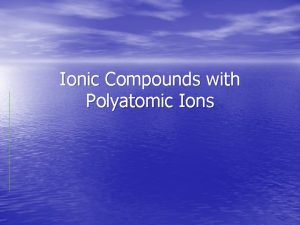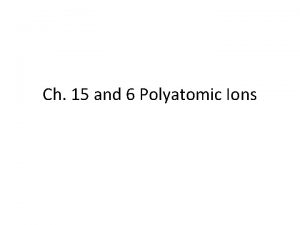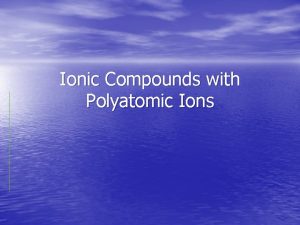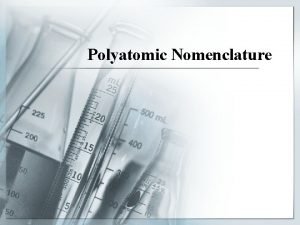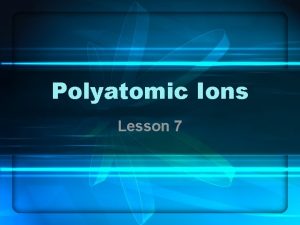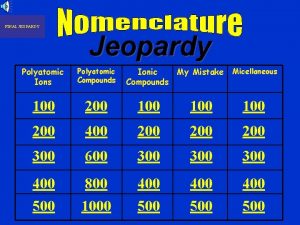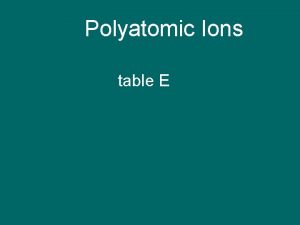Polyatomic Ions Polyatomic Ions Two or more different










![Concept Check: How many IONS are present in each of the following? A) [K]+[OH]- Concept Check: How many IONS are present in each of the following? A) [K]+[OH]-](https://slidetodoc.com/presentation_image/5007a043d3e4696067bd6be9354b8533/image-11.jpg)







- Slides: 18

Polyatomic Ions

Polyatomic Ions • Two or more different atoms covalently bonded together with an overall charge. – These groups of atoms will bond to other ions to form compounds. • Example SO 4 -2 Sulfate ion Compound: Mg. SO 4

Common polyatomic ions *Most polyatomic ions end in either “ate” or “ite” while elements end in “ide”.

6 Polyatomic Ions to Memorize: Name, Formula and Charge • Name Formula and Charge • 1) Ammonium NH 4+

6 Polyatomic Ions to Memorize: Name, Formula and Charge • Name Formula and Charge • 2) Hydroxide OH-1

6 Polyatomic Ions to Memorize: Name, Formula and Charge • Name Formula and Charge 3) Nitrate NO 3 -1

6 Polyatomic Ions to Memorize: Name, Formula and Charge • Name Formula and Charge 4) Carbonate CO 3 -2

6 Polyatomic Ions to Memorize: Name, Formula and Charge • Name Formula and Charge 5) Sulfate SO 4 -2

6 Polyatomic Ions to Memorize: Name, Formula and Charge • Name Formula and Charge 6) Phosphate PO 4 -3

Remember… • Many polyatomic ions include oxygen. – If the name ends in –ate, it will have more oxygen atoms than the other “form. ” – If the name ends in –ite, it will have fewer oxygen atoms than the other “form. ” – Example, sulfate SO 42 - vs sulfite SO 32 -
![Concept Check How many IONS are present in each of the following A KOH Concept Check: How many IONS are present in each of the following? A) [K]+[OH]-](https://slidetodoc.com/presentation_image/5007a043d3e4696067bd6be9354b8533/image-11.jpg)
Concept Check: How many IONS are present in each of the following? A) [K]+[OH]- B) [Na]+[CO 3 -2 ] [Na]+ Ans: 2 Ans: 3 Ans: 4 C) [Na]+ [PO 4]-3 [Na]+ [Na]+

Concept Check • For D- I, circle the polyatomic ion and give the total # of ions (from both monoatomic ions such as Na+1 or Ca+2 and polyatomic ions). D) Na. OH E) Na 2 SO 4 F) Ca 3(PO 4)2 Total ions = 3 Total ions = 5 G) NH 4 OH H) (NH 4)2 S I) Al(NO 3)3 Total ions = 2 Total ions = 3 Total ions = 4

Naming Ternary Salts (compounds with a polyatomic ion) • Simple Naming Rule: Give each ion its name • Example - Name the following • Na. NO 3 sodium nitrate • Na 2 CO 3 sodium carbonate

Practice: Name the following: • Na. OH Ans: sodium hydroxide • Mg(C 2 H 3 O 2)2 Ans: magnesium acetate • NH 4 Cl • Ans: ammonium chloride

Writing Formulas • Find charges of monoatomic ions from periodic table • Look up or memorize charges of polyatomic ions • Sum of charges must total zero; use criss-cross if necessary • If more than one polyatomic ion use ( )

Examples of writing formulas from names: • Ammonium hydroxide = NH 4+1 OH-1 → NH 4 OH • Calcium phosphate = Ca+2 (PO 4 -3) → Ca 3(PO 4 )2

Practice Formulas • calcium nitrate Ans: Ca(NO 3)2 • Cesium hydroxide Ans: Cs. OH • Gallium carbonate • Ans: Ga 2(CO 3)3

Review Practice Formulas • calcium nitrate Ans: Ca(NO 3)2 • calcium nitride Ans: Ca 2 N 3 calcium nitrite Ans: Ca(NO 2)2
 Lirik lagu more more more we praise you
Lirik lagu more more more we praise you More more more i want more more more more we praise you
More more more i want more more more more we praise you Polyatomic vs monatomic ions
Polyatomic vs monatomic ions Polyatomic ions list
Polyatomic ions list Polyatomic ions list
Polyatomic ions list Bicarbonate charge
Bicarbonate charge Hcoo- lewis
Hcoo- lewis Monatomic ion
Monatomic ion Nick the camel ate a clam supper in phoenix
Nick the camel ate a clam supper in phoenix Co42- ion name
Co42- ion name Po polyatomic ion
Po polyatomic ion Naming compounds containing polyatomic ions
Naming compounds containing polyatomic ions Polyatomic ions
Polyatomic ions Anion game
Anion game Dot chemistry
Dot chemistry How to write polyatomic ions
How to write polyatomic ions What are multivalent metals
What are multivalent metals Common polyatomic ions quiz
Common polyatomic ions quiz Polyatomic ions list with charges
Polyatomic ions list with charges


